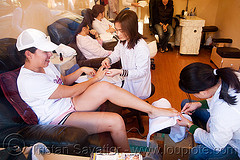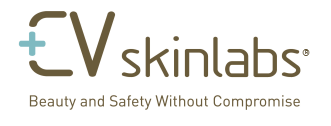
 Know those manicures and pedicures you just love, that help you feel more relaxed and put together? They could be causing salon workers-and perhaps even customers-serious health issues.
Know those manicures and pedicures you just love, that help you feel more relaxed and put together? They could be causing salon workers-and perhaps even customers-serious health issues.
A trio of chemicals is most likely to blame-toluene, formaldehyde, and dibutyle phthalate (DBP) found in most polishes and removers. We told you about them in a former post-how they’ve been linked to reproductive abnormalities, nausea, headaches, dizziness, eye and lung irritation, shortness of breath, and even cancer. As with most things, low exposure may not hurt you, but salon workers are coming in contact with these chemicals 8-10 hours a day, up to six days a week.
The California Breast Cancer Research Program (CBCRP) has taken action to determine just what sort of danger nail salon workers may be in, with the intention of eventually finding out whether or not their increased exposure to chemicals in nail products may be increasing their risk for cancer. “Nail salon workers, in particular,” reports the Asian Health Services in research supported by CBCRP, “have been the focus of health concerns because they routinely handle nail care products containing organic solvents, some of which can cause cancer or affect a woman’s endocrine system….In the coming year, we intend to assess breast cancer rates in this workforce and specifically among Vietnamese workers. We will compare these rates to that of the general female population to answer our first research question: Do nail salon workers have higher breast cancer rates than the general population in California?”
In addition to the cancer question, CBCRP has been investigating other health effects of cosmetic chemical exposure. Findings from their pilot study in 2005 showed that many Vietnamese immigrant workers in the salon industry reported acute health effects and concerns related to workplace chemicals, including skin and eye irritation, breathing difficulties, headaches, and asthma. Since over 80% of California’s nail salons are owned and run by Vietnamese workers, these findings are significant.
What’s particularly discouraging about this is that it’s so unnecessary. There are already several alternative types of nail polish that are made without these dangerous chemicals, and some are already being used in select salons. (See our post mentioned earlier for some options.) The problem lies in educating customers and workers as to the dangers, and increasing demand for these safer products.
“There are readily available, safe products like Go Natural polishes and removers,” says Luanne Bradley, writing for AlterNet on the topic. “But so far for most salon workers, and customers, convention has superseded the health of women. Convincing the $35 billion cosmetics industry to voluntarily commit to reformulating its products is proving harder than getting squeezed in for a last-minute mani-pedi appointment at noon on a Saturday.”
It’s not like other countries haven’t done it. The EU has already banned all phthalates from its cosmetics products.
What to do? If you’re a customer, consider taking along your own non-toxic nail polish to your appointment. If you’re a salon worker, take extra safety precautions. Wear a mask while applying polish, consider protecting your hands with gloves, and take frequent breaks to wash and get some fresh air.
Do you know of other organizations trying to raise awareness of this issue? Please let us know.
Photo courtesy loupiote (Old Skool) via Flickr.com.

